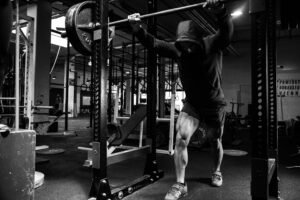Finding the best split for you. Or: So which days are leg days? Part 1
A significant portion of our job in personal fitness involves knowing the best split to use for each individual’s goals and availability. So this is will be the beginning of an ongoing series where we evaluate every credible split out there, compare different splits, and seek definitive answers as to what is best for who.
Our next installments will compare more splits that don’t get the same spotlight as these but can be very effective. And will expand on these to include implementation, sample workouts, and more.
What is a split?
What’s your gym routine like right now? Do you hit biceps and triceps one day, legs the next day, and then chest the following day? Or perhaps you have an upper body day and a lower body day? Maybe you just hit the gym a couple times each week and try to light up your whole body every workout? That’s your training split, and it goes a long way towards determining the results you’re going to get.
Your training split is the breakdown of how you target different muscle groups on different days. There are a wide range of splits in common use, many of which are incredibly effective – for their specific purpose. The challenge is finding one that fits not only your goals, but your schedule and your current abilities.
So, you may already have been debating and trying different splits, you may have only heard the term in passing and are unsure what it’s all about, or you may understand a bit, but still want help finding the one that’s best for you. You might be hesitant to even get started, intimidated by the very idea of organizing all this. No matter what, we’ll sort you out by the end of this series.
what to consider when choosing a split
Because anything is only as effective as its execution, you’ll want to consider all the right factors when making this decision:
Time availability
How much time do you have to get to the gym? Are you trying to maximize a workout window of 2 or 3 days per week? Are you the type who needs to hit the gym as many days as you possibly can? This alone will narrow things down quite a bit. For example, there’s not much reason to use a full-body split if you can make it to the gym 6 days a week. Similarly, if you can only get there 3 times a week, a body-part split isn’t practical at all.
Recovery time
Remember, our muscles grow when they’re repairing, so overtraining is counterproductive. You want to choose a split that you can implement while leaving space for proper recovery periods.
Current abilities
Beginners tend to progress much faster than experienced lifters, who require more specialization and volume to keep seeing gains. Someone just starting can see good progress with a full-body split, but the more advanced won’t benefit much from it.
Goals
Whether you’re looking to bulk up, slim down, gain strength, or you’re just seeking a basic general improvement in fitness, there’s a split that will get you to those goals fastest, and many that will hold you back and slow you down.
HOW MANY DAYS PER WEEK you’ll TRAIN
First, narrow it down by what you’re able to fit into your schedule. Then, by ability: you’re more likely to require more recovery time (you’ll be sore af!) when you just start or just get back to lifting. A good general rule is 3-4 days per week for beginners and 4-6 as you progress.
If you can only workout 2 days a week, a well-executed Push Pull Split or Upper Lower Split can pack a lot of punch into those two workouts. For a beginner, a full-body split might be beneficial here.
If you have 3 days a week, you might consider a push pull leg split, which will fit perfectly into that window.
For 4 or more days per week, you’ll have the entire range to choose from.

what are the most common splits in use?
Let’s take a look at the most common and most effective splits, and examine the why and when of choosing to implement them:
Full Body Split
A full-body split, often used to compensate for a shortage of time, is a program designed to hit every major muscle group in a each workout. It’s technically not even a split, as split implies a division of muscle groups, but we’re calling it one for the sake of comparison.
Full body workouts can, in theory, offer a high frequency of muscle stimulation, since you can train each muscle group multiple times per week, and that can be good for hypertrophy and strength, especially for beginners.
This type of workout is great for fat loss – the compound exercises you’ll be using burn the most calories and boost metabolism and elevate testosterone levels.
There’s also less time commitment, which is great for people with busy schedules.
But the full body split limits variety and over volume for each muscle group. Neglecting smaller muscle groups or more specific movement patterns can put a ceiling on your progress.
Full body splits are best for beginners, those with busy schedules and those with general fitness goals. They are also great for those whose primary goal is to lose fat.
Upper lower split
The upper lower split is, as it sounds, alternating workouts between upper body lifts and lower body lifts.
Whereas full body workouts maximize frequency and body part splits maximize volume, the upper lower split is a good midpoint.
The upper lower split is particularly effective for building your legs, since you can put your legs to work 2-3 times per week
The upper lower split allows for ample recovery time between sessions even with the higher frequency.
It’s also a great calorie burner, composed mostly of compound lifts, so it’s easier to keep fat off as you work to improve strength and size.
The upper lower split is a great choice for many intermediate lifters – you can target muscle groups twice a week with just 4 workouts. Hypertrophy has been shown to be best achieved by targeting muscle groups twice a week. This split is also a great natural progression from a beginner full-body split.
Upper-lower training splits do leave shorter recovery time between training sessions, so make sure you’ll be able to stick to your planned recovery days.
push pull split
A split based around the concept that everything we do is either a push or a pull. One day you’ll work all the push muscles such as shoulders, chest, triceps, and on the next, the pull muscles like lats and biceps.
This split also allows muscle groups to be targeted twice a week. Push/pull is best-suited for the intermediate-advanced. they’re efficient and flexible, while giving all of your muscle groups a good amount of work in a week.
This split can leave your days imbalanced, however. Push days can include the squat, bench press and overhead press. One solution is to shift legs to pull days. Another solution takes us into our next split:
Push Pull Legs
The Push Pull split with a separate day for legs. Frequency and volume can be a benefit or a drawback here. If you have the time and ability to recover and can train six days a week, this split is a great option. But even if you’re on a 3 day per week plan, the PPL allows you to train every muscle group in just three days and with a good amount of training volume. This is a great, flexible split for building muscle and strength.
Because you’re hitting opposing muscle groups on different days, you’ll get good rest even with a 6 day program.
A PPL may not provide enough specialization for those more focused on aesthetics, however. Which leads us into:
Body part split
The body part split, also knows as the bodybuilder split, or the ‘bro split’, is the gym cliche of training specific muscle groups each day – having a chest & triceps day, a back & biceps day, a leg day, and so on.
It’s heavy on assistance exercises, providing the greatest volume and specialization for each muscle group. This can be good for shocking muscles into growth and breaking through plateaus.
The body part split also provides a full week of recovery before targeting a muscle group again.
And as specialized as it seems, compound lifts really do work a vast array of muscle groups, so you will still be training muscle groups multiple times a week.
For those addicted to going to the gym and can’t stand to skip days, the body part split allows you to hit the gym effectively for 6 or even 7 days a week.
On the ‘Con’ side – though the body part split maximizes volume, it does so at the expense of frequency – that full week before you target the same muscle group. For most lifters and most weight room goals, maximizing frequency is more effective than maximizing volume.
And if you can’t (or just won’t) make it to the gym at least 5 days per week, the body part split won’t be practical or efficient.
It’s a good split for serious lifters, and those who want to bulk or fine-tune their physique. But most people would be better served by a split with higher frequency for each muscle group.
what to do with all this

As you process and evaluate which split to go with, the benefit of an expert can’t be overstated. Having elite coaches assess your abilities, goals and lifestyle and structure your fitness program for you can make all the difference.

